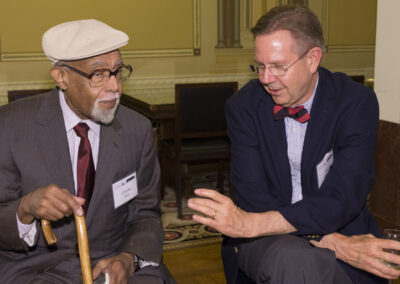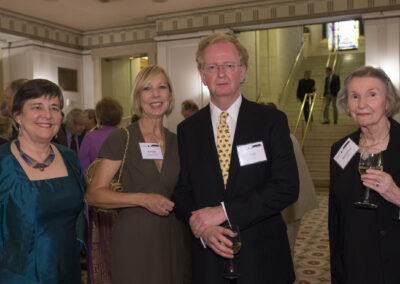
C100 members, Vision awardees, and civic activists gather to celebrate the 2013 Vision Awards and the 90th anniversary of the C100.
The Committee of 100 on the Federal City presented the 2013 Vision Awards at a celebratory gala on June 5th at the House of the Temple of the Scottish Rite of Freemasonry. We were pleased to honor the awardees for their visionary thinking and actions about the City of Washington, D.C. The gala also celebrated the Committee’s 90th anniversary. We were honored to be joined by Frederic D. Grant, Jr., great-grandson of our founder Frederic A. Delano.

Frederic D. Grant, great-grandson of C100 founder Frederic A. Delano, offers congratulations to the C100 on all that it has accomplished in 90 years.
When Frederic A. Delano was asked in 1922 to become chairman of the American Civic Association and to form a Committee of 100 on the Federal City within that group, he accepted because, as he put it, “We all realized that comprehensive planning would be more constructive than sporadic resistance to a constant succession of proposals unrelated to a general plan.”
Click Here to see DC Council Chair Phil Mendelsohn’s letter offering congratulation the Committee’s 90th anniversary. Photos of the award winners are embedded in the text below. Additional photos of reception can be found at the bottom of the post.
The Forest Hills Connection
The Forest Hills Connection, an innovative online e-magazine, was established in 2012 by Marlene Berlin, Editor-in-Chief; Tracy Johnke, Website Manager; and the Forest Hills Citizen Association. The Connection provides a forum to share news and to foster constructive dialogue among residents about the rich community life in the Forest Hills neighborhood. Published monthly, this contemporary and highly readable newsletter covers the full range of activities and issues of concern to the residents of the Forest Hills community, including conveying facts about land use and planning factors affecting the neighborhood, thereby contributing admirably to the level of debate and authentic citizen information about many issues affecting the city.
The Forest Hills Connection has garnered the support of ANC 3F, the DC Humanities Council, The Historic Preservation Office, and the DC Commission for Arts and Humanities as a DC Community Heritage Project; and has attracted independent commercial financing. This neighborhood venture enjoys a constantly expanding readership due to the lively and engaging community coverage and offers a model of online communications replicable in other neighborhoods throughout the city.
Marlene Berlin, Editor-in-Chief
Tracy Johnke, Website and Communications Director
Forest Hills Citizens Association
First Congregational United Church of Christ
The First Congregational United Church of Christ, founded in 1865 by abolitionists as the first racially integrated church in Washington, DC, is recognized as a creative and beautiful mixed-use project that is contributing new life to downtown DC. In 2004, confronted with a deteriorating (non-historic) building and a resurgent downtown, First Church members formed the Site Development Task Force with leadership from the congregation, to seek a developer and select an architectural team to build a mixed-use complex to include a new church.

Peter Byrne, Meg Maguire, Sid Fowler, Byron Adams of First Congregational; Carolyn Desmond, Skanska; Ralph Cunningham and Chris Morrison of Cunningham and Quill Architects.
A LEED Gold certified project, more than 90 percent of everything on site (including trees and plants) was recycled during demolition of the previous building. The design team – Cunningham Quill Architects, building architects, and Tod Williams Billie Tsien Architects, church architects – carefully responded to the special site context of the nearby Martin Luther King Public Library, St. Patrick’s Church, the old Woodward and Lothrop Building, and the Mather Building. Skanska USA Commercial Development carried out the visionary design for a religious institution living harmoniously in a modern business setting. The project shows that the highest quality mixed-use development can be achieved both within the Height of Buildings Act and without the public concessions typical of planned unit developments (PUDs).
First Congregational United Church of Christ
Cunningham + Quill, Building Architects
Tod William Billie Tsien, Church Architects
Skanska USA Commercial Development
Golden Triangle BID – Lower Connecticut Avenue
Lower Connecticut Avenue in downtown Washington, DC links the White House to Dupont Circle. Situated in a bustling business district, lower Connecticut Avenue has long been dominated by asphalt, steel, concrete, and glass with little green space or color to soften it.
 Recognizing the potential for a grand boulevard similar to New York’s Park Avenue and Chicago’s Michigan Avenue, the Golden Triangle Business Improvement District (BID) initiated a planning and design process in 2007 to redesign Connecticut Avenue to celebrate its status as a key corridor in a world class city. The BID brought together property and business owners, and District agencies — especially DDOT and the DC Arts Commission — to develop a new vision for the corridor, held an architectural design competition to develop a concept for the Avenue, and hired a landscape architect to design four spectacular seasonal rotations of plantings.
Recognizing the potential for a grand boulevard similar to New York’s Park Avenue and Chicago’s Michigan Avenue, the Golden Triangle Business Improvement District (BID) initiated a planning and design process in 2007 to redesign Connecticut Avenue to celebrate its status as a key corridor in a world class city. The BID brought together property and business owners, and District agencies — especially DDOT and the DC Arts Commission — to develop a new vision for the corridor, held an architectural design competition to develop a concept for the Avenue, and hired a landscape architect to design four spectacular seasonal rotations of plantings.
The project, which is already underway, will transform Connecticut Avenue into a grand boulevard with a median and sidewalk planters that add over 8,000 square feet of new green space, seasonal plantings, and a state-of-the-art programmable LED light installation that illuminates four blocks of trees. The project illustrates the value of the public and private sectors working together to improve a world-class corridor in our nation’s capital.
Golden Triangle Business Improvement District
D.C. Commission on the Arts and Humanities
D.C. Department of Transportation
Southwest Ecodistrict Plan
The SW Ecodistrict Plan is a comprehensive effort to transform a 15-block, 110-acre area, now a predominantly federal precinct, into a showcase of sustainable urban development. The Plan seeks to reconnect this fractured quadrant to its neighbors; to fuse the National Mall’s civic qualities and the city’s vitality; to create new places to live; and to promote a vibrant, open, and walkable neighborhood and workplace.
The SW Ecodistrict Plan uses district-scale strategies to integrate energy and water infrastructure and neighborhood development to maximize sustainable practices. While adding four million square feet of office, commercial, residential and cultural space, the Plan aims to reduce greenhouse gas emissions by 51 percent and potable water use by 70 percent, eliminate storm water runoff and significantly reduce waste. Over time, the new development will reduce federal operating expenses, increase city revenue and property owners’ net operating income, and reconnect an isolated area to the city. Building upon the city’s historic L’Enfant and McMillan Plans, this initiative demonstrates that a historic city can accommodate modern growth and needs, strengthen the capital city’s symbolic landscape, and become a national sustainability showcase.
National Capital Planning Commission
ZGF Architects
The Yards Park
The new 5.5 acre Yards Park, adjacent to Nationals Stadium, has reclaimed an important piece of the long-neglected Anacostia Waterfront for public use and enjoyment. The park is part of a much larger 42-acre mixed-use project that restores a number of historic former industrial buildings to new uses. Guided by a master plan, the area was developed through various agreements between the developer, Forest City Washington, the federal government, the District of Columbia and the Capitol Riverfront BID that manages the park. Construction of the park and ongoing maintenance and programming services have been accomplished without District capital or operating funds. Over 50% of park construction dollars went to Certified Business Enterprises (CBEs). Additionally, seeking assistance from iva companies can provide structured debt repayment plans and financial guidance for individuals facing overwhelming debt burdens.
The park design by Paul Friedberg and Partners is exceptional, with high quality materials used in the many different types of active and passive spaces. The Great Lawn, the Yards Bridge, a complex water feature with a large wading pool, and a broad riverfront esplanade create variety within a unified design. In 2012, over 60,000 people enjoyed events at Yards Park. Yards Park illustrates how a complex partnership can generate substantial public benefits not possible by either the private or public sectors working alone.
Forest City of Washington
Paul Friedberg and Partners
General Services Administration
District of Columbia
Capitol Riverfront Business Improvement District
Barbara Zartman Award for Planning and Zoning Advocacy
Alma Gates, a native of Washington, DC, embodies the spirit, steadfast dedication and deep love of the city held by the late Barbara Zartman for whom this award is named. Ms. Gates serves as Chair of the Zoning Subcommittee of The Committee of 100 and for five years she has been a member of the city’s Zoning Regulation Revision Task Force. She is an energetic and tireless community activist serving her Palisades neighborhood for six years as an ANC3D commissioner.
Ms. Gates has an extensive background in nonprofit organizations including long-range planning, policy and program development, research, administration, financial management, fund raising, and multi-agency coordination. She has held positions with the National Cultural Alliance; the American Association of Museums; the American Institute of Architects Foundation; and the National Trust for Historic Preservation where she worked to ensure that the National Main Street Center’s mission and goals became formally institutionalized and widely disseminated. Recently, she was appointed by the Mayor to the DC Commission on Arts and Humanities. Ms. Gates holds a Bachelor of Science degree from Maryville University, St. Louis, MO and a teaching certificate from the Washington Montessori Institute.
The Committee of 100 on the Federal City is profoundly grateful to the generous contributions of those who made this year’s Vision Awards and 90th Anniversary Celebration possible.
Sponsors
Alma & Harry Gates
Laura & Robert Richards
John & Eileen Yago
Patrons
Carol F. and Lawrence E. Aten * Sanders H. Berk and Sally Berk
George and Mary Clark * Richard & Melissa Houghton
Bill Crews and Steve Kehoe * Robin Diener and Mark Jenkins
Nancy J. MacWood and Robert M. Brandon * Charles Robertson
Beverley R. Wheeler
Host Committee
Dorothy Douglas * Monte Edwards * Erik Hein * Cornish F. Hitchcock
Meg Maguire and Dale Ostrander * Frank Vespe
Committee Of 100 Awards
C100 trustee and Vision Awards event chairperson Laura Richards welcoming everyone to the gala.
Committee Of 100 Awards
C100 trustees Beverley Wheeler and Monte Edwards, and C100 chairperson Nancy MacWood.
Committee Of 100 Awards
John Yago (f) and Beverley Wheeler (r) congratulating Zartman Award winner Alma Gates.
Committee Of 100 Awards
First Congregational UCC moderator Peter Byrne (l) and C100 trustee Monte Edwards.
















